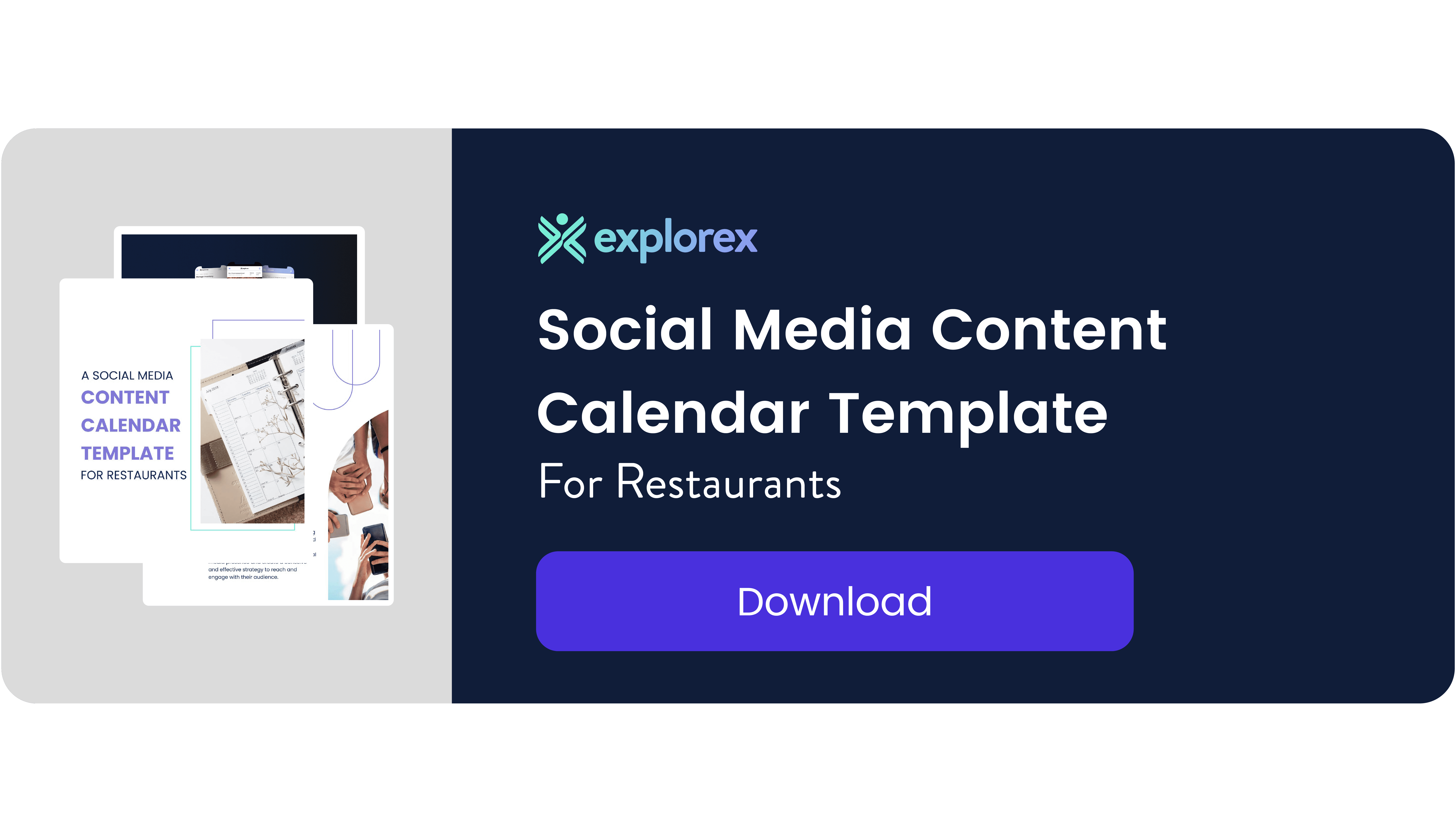What is Restaurant Marketing?
Restaurant marketing is the art of promoting a restaurant to potential customers to increase awareness, drive traffic, and, ultimately, increase sales. It’s a multifaceted approach that requires creativity, strategy, and a keen understanding of your target audience.
Think of it this way – the restaurant industry is incredibly competitive, with new restaurants constantly popping up. To stand out, you must have a clear brand identity and a unique selling proposition (USP) that sets you apart. Once you’ve defined your brand, you can develop a marketing plan incorporating various tactics to reach your target audience.
As a business owner, you know that your customers are the foundation of your enterprise. Whether they are loyal regulars who have developed a personal rapport with your staff or visitors from out of town who have stumbled upon your establishment in search of Wi-Fi but leave impressed with your food and hospitality, each one of them are crucial for the success of your business. Your customers’ patronage and support drive your business forward, and it is imperative to consistently provide them with high-quality service and products to maintain their loyalty and satisfaction.
But, Why is restaurant marketing important?
The market is becoming increasingly competitive, and it has become crucial for businesses in the food industry to have a strong marketing plan in place to differentiate themselves from the competition.
To gain an edge in the competitive market, restaurant owners and managers must stay updated with the latest marketing trends and strategies. Ultimately leading to the goal of creating a loyal customer base that keeps coming back for more. By consistently delivering a high-quality experience that aligns with your brand, you can turn first-time customers into regulars and grow your business over time.
This is where this comprehensive guide comes in. In this guide, we will look in-depth at the most recent and effective marketing tactics restaurants can use to attract and retain customers. From social media marketing to influencer partnerships, we will cover all the critical aspects of restaurant marketing. Additionally, provide expert tips on optimizing your website and online ordering system to provide a seamless customer experience.
So, where do you start?

Creating a killer marketing strategy involves these key steps:
- Define your target audience:
Identify who your customers are, what they like, and what they want. This could include demographics, such as age, gender, income, and location, as well as psychographics, such as lifestyle, interests, and behaviors.
- Develop a unique brand and messaging:
Develop a unique brand that stands out from your competitors and resonates with your target audience. This could include your logo, colors, tagline, and messaging. Make sure your messaging communicates the unique value proposition of your restaurant, such as the quality of your ingredients, the authenticity of your cuisine, or the ambiance of your dining experience.
- Create a website and social media presence:
Develop a website that showcases your menu, location, hours, and contact information. Use social media platforms such as Facebook, Instagram, and Twitter to engage with customers, promote your menu, and showcase your restaurant’s ambiance.
- Leverage local SEO:
Optimize your website and online listings for local SEO to ensure your restaurant appears in local search results when customers are looking for nearby dining options. This could include optimizing your Google My Business listing, creating local content, and earning online reviews.
- Use email marketing:
Develop an email marketing strategy to stay in touch with your customers and promote specials, events, and new menu items. Encourage customers to sign up for your email list with incentives such as a free appetizer or dessert.
- Host events and promotions:
Host special events and promotions such as wine tastings, live music, or holiday-themed menus. Promote these events through your website, social media, and email marketing.
- Partner with local influencers and media:
Collaborate with local influencers such as food bloggers and journalists to promote your restaurant and menu. Offer them complimentary meals or special access to your kitchen in exchange for social media or media coverage.
Next, Analyze your Marketing Efforts:

By analyzing your marketing efforts, you can measure their effectiveness in achieving your business objectives. You can track metrics such as website traffic, social media engagement, and conversion rates to see how well your marketing campaigns are performing.
- Track and analyze key performance indicators (KPIs):
Monitor KPIs such as website traffic, social media engagement, email open rates, click-through rates, and conversion rates to measure the effectiveness of your marketing efforts. Use tools such as Google Analytics, social media analytics, and email marketing software to track these metrics.
- Monitor and respond to online reviews:
Regularly monitor and respond to online reviews on platforms such as Zomato, Google, and TripAdvisor. Use customer feedback to identify areas for improvement and make necessary changes to your restaurant’s operations.
- Conduct customer surveys:
Conduct customer surveys to gather feedback on your restaurant’s menu, service, ambiance, and overall experience. Use this feedback to improve your restaurant’s offerings and customer experience.
- Analyze your competition:
Analyze your competitors’ marketing strategies and offerings to identify opportunities and threats in the market. Use this information to create a competitive advantage that differentiates your restaurant from the rest.
- Evaluate the return on investment (ROI) of your marketing efforts:
Evaluate the ROI of your marketing efforts by comparing the cost of your marketing campaigns to the revenue generated by these campaigns. This can help you determine which marketing channels and tactics are most effective in driving business growth.
But, to market your restaurant, you first need to come up with an effective marketing budget.
How to create a Marketing Budget:
Creating a marketing budget for your restaurant is an essential part of your overall business strategy. Here are some key steps to help you:
- Determine your marketing objectives:
Identify your marketing objectives and goals, such as increasing customer visits, boosting sales, or expanding your customer base. Make sure your marketing budget aligns with these objectives.
- Identify your target audience:
Identify your target audience and the channels they use to consume media. This could include social media, email, print, or outdoor advertising. Your budget allocation should reflect the channels your target audience uses the most.
- Develop a comprehensive marketing plan:
Develop a comprehensive marketing plan that includes all the tactics you plan to use to achieve your objectives, such as social media campaigns, email marketing, print advertising, or event marketing.
- Research costs:
Research the costs associated with each tactic and channel you plan to use. This could include the cost of advertising on social media, printing and distributing flyers or hosting events.
- Set a budget:
Set a realistic budget based on the costs associated with each tactic and channel, as well as your overall marketing objectives. Make sure your budget is realistic and reflects the resources you have available.
- Track and adjust your budget:
Monitor your marketing budget closely and adjust it as necessary based on your results. If a tactic is not producing the desired results, consider reallocating your budget to a more effective tactic or channel.
Finally, Calculate the ROI for your marketing budget
Calculating the return on investment (ROI) for your restaurant marketing budget is an important step in measuring the effectiveness of your marketing campaigns. Here are the steps you can follow to calculate the ROI for your restaurant marketing budget:
- Determine the total cost of your marketing campaign:
Add up all the costs associated with your marketing campaign, including advertising costs, printing and distribution costs, website development costs, and any other expenses.
- Identify the revenue generated from your marketing campaign:
Calculate the revenue generated from your marketing campaigns, such as the increase in sales, new customers acquired, or the average value of a customer visit. This can be done by tracking customer purchases or through customer surveys.
- Calculate the profit from your marketing campaign:
Subtract the total cost of your marketing campaign from the revenue generated to calculate your profit.
- Divide the profit by the total cost of your marketing campaign:

Divide the profit by the total cost of your marketing campaign, and then multiply the result by 100 to get a percentage. This percentage is your ROI for your restaurant marketing budget.
With time restaurant marketing is constantly evolving, staying on track with the latest trends and strategies is crucial to stay competitive. Whether you’re building a strong online presence, offering online ordering and delivery, creating engaging content, hosting events, or partnering with influencers, there are endless possibilities to market your restaurant effectively.
However, it’s important to remember that only some marketing strategies work for some restaurants. It’s essential to experiment with different tactics and customize them to attract the right customers for your restaurant. By understanding your target audience and their preferences, you can create a marketing plan that resonates with them and drives more traffic and sales to your business.
So, feel free to try new things and keep your marketing game on top. By staying innovative and adaptable, you can build a strong brand and establish your restaurant as a go-to destination for foodies in your area.





